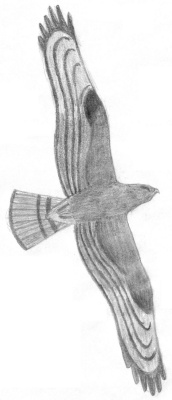Honey Buzzard at Burghfield Gravel Pits

8 Sep 2002 | Marek Walford
Honey Buzzard Pernis apivorus
Dark morph juvenile
Burnthouse Lane, Burghfield Gravel Pits, Berkshire (SU689686)
7th September 2002
Whilst standing between the pits at Burnthouse Lane watching groups of Lesser Black-backed Gulls flying over a large dark bird gliding on flat wings caught my eye. It was about half a mile away over Green Park. I set my scope up and it was immediately obvious that it was a Buzzard species. I was waiting for it to adopt the classic "V" shaped wings of Common Buzzard but as it got closer it became apparent that it was actually a Honey Buzzard. It flew directly overhead at a height of about 100 metres, soaring over the southern pit and even hovering on one occassion before flying off south-west over the ROF complex. It was on view for a total of twelve minutes between 13:45 and 13:57.
It had a small head and a long neck making the head stick out from the body. The wings were long. While gliding they were held slightly down curved and were never raised above the horizontal, even when the bird was soaring. It only flapped it`s wings on two occassions. The wing beats were fluid and extended from a horizontal position almost through ninety degrees. As it flew away the wings were seen to be slightly bent back at the carpal joint.
The tail appeared long although this was less apparent when the tail feathers were fanned out. While gliding they were mostly held closed. It fanned it`s tail feathers while soaring and on occassion twisted it`s tail in the same way as a Kite does.
It was obviously a dark morph bird and the four evenly spaced bars across the underside of the primaries and secondaries and the dark head identified the bird as a juvenile.
Size: It appeared slighly larger than the Lesser Black-backed Gulls.
Head: Dark brown. Black mask around eye.
Eye: Eye colour not noted but presumably dark as it didn`t stand out from the black mask.
Bill: Yellow.
Under parts: Uniformly dark brown. Legs yellow.
Wings: Primaries and secondaries grey, lighter across the primaries. Three evenly spaced bars across primaries and secondaries. Tips of primaries and secondaries narrowly edged dark forming a fourth bar. Wing tips black. Coverts dark brown with a darker patch on the carpal joint.
Tail: Grey with three distinct dark horizontal bars; two close together at the base of the tail and one at the tip.
Previous experience of species:
I used to live in Fakenham, Norfolk just a few miles from the Swanton Novers Raptor Watch Point where both Honey and Common Buzzards breed. I used to see the Honey Buzzards on a regular basis, often side by side with Common Buzzards. Although probably the same half a dozen individuals I`ve probably seem them on at least twenty occassions as well as the odd bird on passage away from the watch point.
Elimination of confusion species:
Common Buzzard, especially a juvenile can be confused with Honey Buzzard. The long wings, long tail and protruding neck of this individual suggest Honey Buzzard but the three bars on the tail is diagnostic.
I am 100% certain of my identification. This description and the accompanying sketch have been taken from field notes.